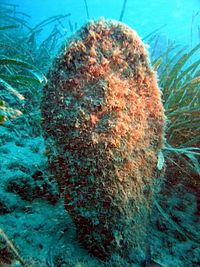
Photo from wikipedia
Disease is an increasing threat for marine bivalves worldwide. Recently, a mass mortality event (MME) impacting the bivalve Pinna nobilis was detected across a wide geographical area of the Spanish… Click to show full abstract
Disease is an increasing threat for marine bivalves worldwide. Recently, a mass mortality event (MME) impacting the bivalve Pinna nobilis was detected across a wide geographical area of the Spanish Mediterranean Sea and linked to a haplosporidian parasite. In 2017–2018, mass mortality events affecting the pen shell Pinna nobilis were recorded in two different regions of Italy, Campania and Sicily, in the Tyrrhenian Sea (Mediterranean Sea). Histopathological and molecular examinations of specimens showed the presence of Haplosporidium sp. in only one specimen in one area. Conversely, in all of the surveyed moribund animals, strong inflammatory lesions at the level of connective tissue surrounding the digestive system and gonads and linked to the presence of intracellular Zhiel-Neelsen-positive bacteria were observed. Molecular analysis of all of the diseased specimens (13) confirmed the presence of a Mycobacterium. Blast analysis of the sequences from all of the areas revealed that they were grouped together with the human mycobacterium M. sherrisii close to the group including M. shigaense, M. lentiflavum and M. simiae. Based on pathological and molecular findings, it is proposed that a mycobacterial disease is associated with the mortality episodes of Pinna nobilis, indicating that, at this time, Haplosporidium sp. is not responsible for these events in Campanian and Sicilian waters.
Journal Title: Scientific Reports
Year Published: 2018
Link to full text (if available)
Share on Social Media: Sign Up to like & get
recommendations!